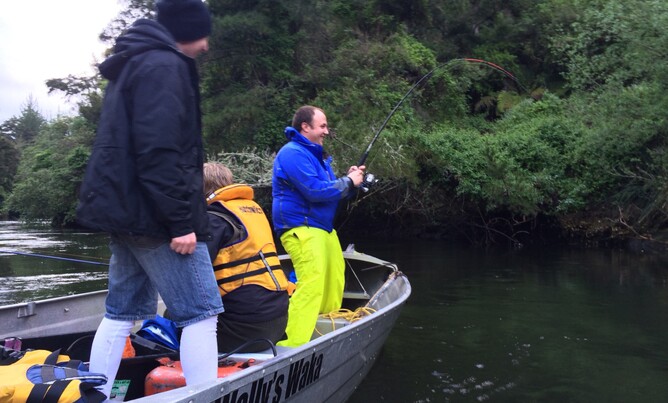As Cambridge locals, we had been on Lake Karapiro many times before – house boating, wakeboarding and a few failed attempts at shoreline fishing. With a range of experience in the crew from saltwater bait fishing to small stream fly fishing, we were all still water fishing noobs – and it showed, by failing to get any fish to the boat on this maiden trip. However, we followed things up with a much more successful Karapiro Part 2.
Karapiro part one
The Hydro Lakes have two distinct parts. The top part of the Lakes are fast moving and narrower, more like a large river. Once the flow slows to be unnoticeable and the Lake widens it becomes more of a still water fishery.
We started fishing in the afternoon, launching our fleet of two tinny's at the Little Waipa Reserve. While the stream mouth there is a popular and apparently productive place to fish, we wanted to get away from the campervan crowd and explore the top of the Lake nearer the Arapuni Dam, as we'd heard these places hold the biggest fish on the Hydro Lakes.
It was too dark to change locations and tie up further downstream, so as we squinted our way back to the boat ramp through clouds of caddis, I was determined to return with a fly rod and caddis dry flies to find out just how big the fish were that we heard splashing.
Karapiro Part Two
This time we started by exploring the Waititi Stream. Flow here was low and we ran into some other fishermen. As it's a small stream, we decided to head back to the main part of the Lake.
We headed for the spot where we had heard the large splashes coming from the darkness on our first trip. Seeing it in the daylight we could see it was a huge corner pool, where the main current blasts past a rocky outcrop and leaves a large area of slack water on the inside of the bend. This is where my stream fly fishing experience reminded me that trout are typically hungry and lazy. They want as much food as possible for as little effort. The majority of the fish were within 10 metres of the line where the main flow joins the slack water – essentially a conveyor belt of food flowing past while spending most of their time in the slack water.
This time I was prepared for the caddis hatch with my fly rod and floating line. While most of the rises were a little beyond my roll cast distance, I managed to land my fly close to the edge of the slack water and a 2lb rainbow rose aggressively to take my elk hair caddis – stoked!
The lack of an available back cast made it difficult to reach the fish catching zone with a dry fly. On dusk, I tried swinging a large olive articulated fly down and across the current. Articulated flies have two hooks connected by beading wire in the middle, which means you can create much larger flies that still hook fish whether they nip the tail or attack the head. The hinged connection give them a very fishy action in the water. A 2lb brown trout liked the look of my offering and I had another one to the bank.
The other lads were having good success with Toby's fished below a ball sinker. This extra bit of depth from the ball sinker seemed to help with more hook ups as the toby swung around in the downstream current.




